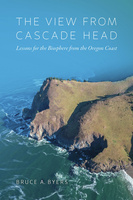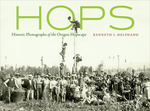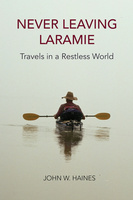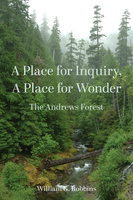Oregon State University Press
For fifty years, Oregon State University Press has been publishing exceptional books about the Pacific Northwest—its people and landscapes, its flora and fauna, its history and cultural heritage. The Press has played a vital role in the region’s literary life, providing readers with a better understanding of what it means to be an Oregonian. Today, Oregon State University Press publishes distinguished books in several academic areas from environmental history and natural resource management to indigenous studies.
Touching This Leviathan
Touching This Leviathan asks how we might come to know the unknowable—in this case, whales, animals so large yet so elusive, revealing just a sliver of back, a glimpse of a fluke, or a split-second breach before diving away.
Whale books often sit within disciplinary silos. Touching This Leviathan starts a conversation among them. Drawing on biology, theology, natural history, literature, and writing studies, Peter Wayne Moe offers a deep dive into the alluring and impalpable mysteries of Earth’s largest mammal.
Entertaining, thought-provoking, and swimming with intelligence and wit, Touching is Leviathan is creative nonfiction that gestures toward science and literary criticism as it invites readers into the belly of the whale.
This Is Not For You
An Activist's Journey of Resistance and Resilience
This Is Not For You tells the story of activist and photographer Richard Brown, a Black Portlander who has spent decades working to bridge the divide between police and the Black community. His memoir brings readers with him into the streets with fellow activists, into squad cars with the rank-and-file, and to regular meetings with mayors and police chiefs. There are very few people doing the kind of work Richard Brown has done. And that, as he sees it, is a big problem.
The book finds Brown approaching his eightieth birthday and reflecting on his life. As he recalls his childhood in 1940s Harlem, his radicalization in the newly desegregated Air Force, and his decades of activism in one of America’s whitest cities, he questions how much longer he’ll do this work, and he wonders who, if anyone, will take his place.
This is a book about how and why to become an engaged, activist citizen, and how activists can stay grounded, no matter how deeply they immerse themselves in the work. It also offers an intimate, firsthand look at policing: what policing is and could be, how civilians can have a say, and how police can and should be responsive to and inclusive of civilian voices. This Is Not For You speaks on every page about being Black in America: about Black pride; Black history, art, and culture; and the experience of resisting white supremacy. It also stands as a much-needed counternarrative to Portlandia, telling a different story about the city and who has shaped it.
Over fifty percent of royalties earned on this book will be donated to organizations working on behalf of Black Portlanders.
The View From Cascade Head
Lessons for the Biosphere from the Oregon Coast
Hops
Historic Photographs of the Oregon Hopscape
The craft brewing renaissance of recent decades has brought a renewed interest in hops. These vigorous vines, with their flavorful flowers, have long played a key role in beer making and in Oregon’s agricultural landscape. This compendium of photographs offers a visual dive into the distinctive physical presence of hops in the state. From pickers and poles to cones and oasts, Kenneth I. Helphand brings the landscape and culture of hops to life.
Storm Beat
A Journalist Reports from the Oregon Coast
Clifford Gleason
The Promise of Paint
Clifford Gleason: The Promise of Paint serves as both an introduction and a definitive study of an “artist’s artist,” who until now has not received the sustained attention that he and his work are due. It traces his career from the 1930s until the last months of his difficult life—difficult because of alcoholism, near poverty, and homosexuality in a repressive era. In paint, Gleason found the only realm in which he felt competent, confident, and successful; paint offered the promise of accomplishment. Published in conjunction with an exhibition at the Hallie Ford Museum of Art at Willamette University, this richly illustrated monograph examines Gleason’s identity as a modern artist as he responded to the rapid changes in artistic modernism from the late 1930s, when he studied with Louis Bunce at the Salem Federal Art Center, to the 1970s, when he rethought the legacy of Abstract Expressionism in works that are unique to him, visually beautiful and poetically expressive.
The Environmental Politics and Policy of Western Public Lands
Editors Erika Allen Wolters and Brent Steel have assembled a stellar cast of scholars to consider long-standing issues and topics such as endangered species, land use, and water management while addressing more recent challenges to western public lands like renewable energy siting, fracking, Native American sovereignty, climate change, and land use rebellions.
A Place for Inquiry, A Place for Wonder
The Andrews Forest
The H.J. Andrews Experimental Forest is a slice of classic Oregon: due east of Eugene in the Cascade Mountains, it comprises 15,800 acres of the Lookout Creek watershed. The landscape is steep, with hills and deep valleys and cold, fast-running streams. The densely forested landscape includes cedar, hemlock, and moss-draped Douglas fir trees. One of eighty-one USDA experimental forests, the Andrews is administered cooperatively by the US Forest Service, OSU, and the Willamette National Forest. While many Oregonians may think of the Andrews simply as a good place to hike, research on the forest has been internationally acclaimed, has influenced Forest management, and contributed to our understanding of healthy forests.
In A Place for Inquiry, A Place for Wonder, historian William Robbins turns his attention to the long-overlooked Andrews Forest and argues for its importance to environmental science and policy. From its founding in 1948, the experimental forest has been the site of wide-ranging research. Beginning with postwar studies on the conversion of old-growth timber to fast-growing young stands, research at the Andrews shifted in the next few decades to long-term ecosystem investigations that focus on climate, streamflow, water quality, vegetation succession, biogeochemical cycling, and effects of forest management. The Andrews has thus been at the center of a dramatic shift in federal timber practices from industrial, intensive forest management policies to strategies emphasizing biodiversity and healthy ecosystems.










